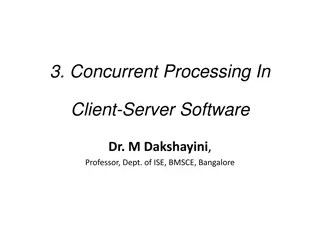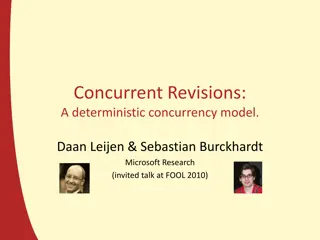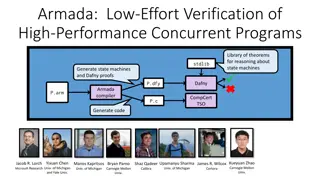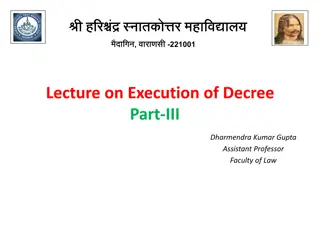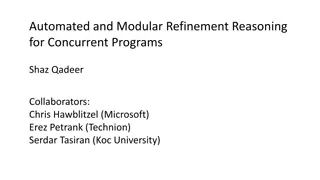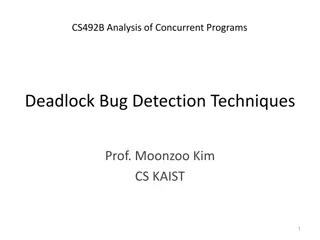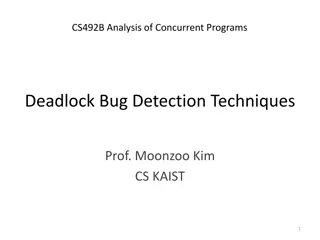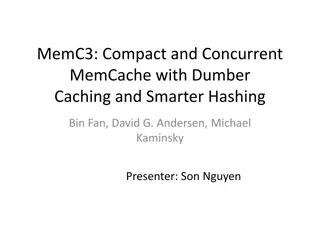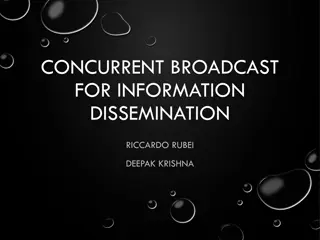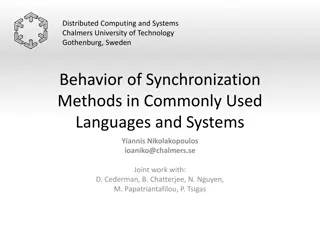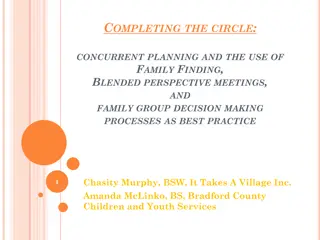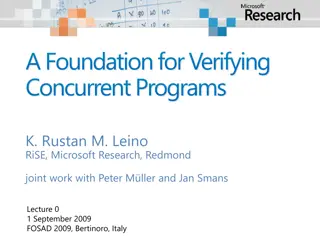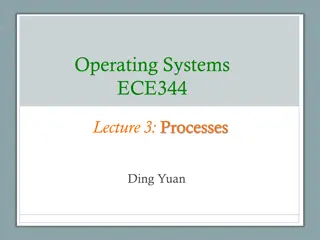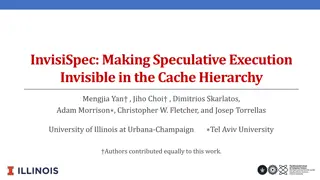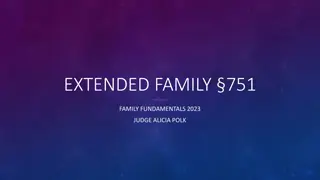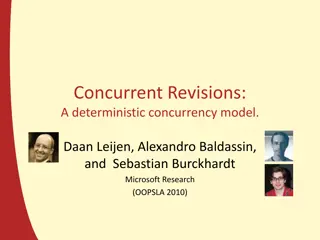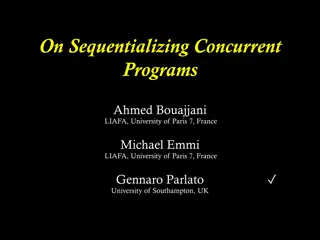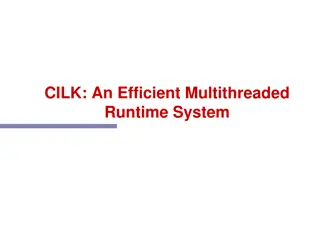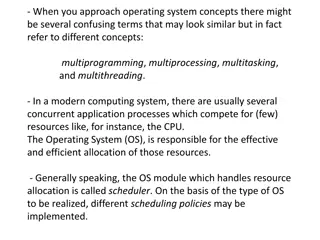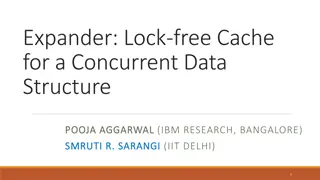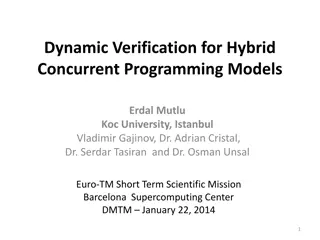Understanding Threads, Linked Lists, and Programming Models in Concurrent Programs
Delve into the concepts of threads, linked lists, and programming models in concurrent programs. Explore the use of threads for handling multiple requests, the struct types in programming, and the various access methods for lists. Learn about the benefits of threads and how they enable parallel proc
0 views • 44 slides
Issues and Algorithms in Server Software Design
The content discusses fundamental issues in server software design such as connectionless vs. connection-oriented access, stateless vs. stateful applications, and iterative vs. concurrent server implementations. Various server algorithms like iterative and concurrent servers are explained with their
3 views • 44 slides
Understanding Atomicity Violation in Concurrent Programs
Explore the concept of atomicity violation in concurrent programs along with detection techniques to ensure the integrity of critical code blocks. Learn from examples and insights shared by Prof. Moonzoo Kim.
0 views • 23 slides
Understanding CRSC and CRDP Programs for Veterans
Learn about Combat-Related Special Compensation (CRSC) and Concurrent Retirement and Disability Pay (CRDP) programs, eligibility criteria, application process, and how these programs help veterans receive rightful benefits without offsetting payments. Explore the history, prohibition on concurrent r
1 views • 32 slides
Understanding Concurrent Processing in Client-Server Software
Concurrency in client-server software involves simultaneous computing processes among multiple users or processes within a network. Dr. M. Dakshayini explains the importance of concurrency in distributed computing and its various forms such as time-sharing and multiprocessing. The design and impleme
3 views • 26 slides
Understanding the Neglected Provisions of Order XXI CPC, 1908
Explore the overlooked aspects of Order XXI CPC, 1908, focusing on the definitions, types of decrees, modes of execution, procedures for executing decrees, reasons for neglect, impact, recommendations, and conclusion. Learn about neglected provisions like summary execution, execution against legal r
0 views • 14 slides
Arkansas Concurrent Challenge Scholarship Program Details
The Arkansas Concurrent Challenge Scholarship Program provides eligible high school juniors and seniors with financial assistance for up to two concurrent credit courses per semester. Students can receive $125 per course, with a maximum of four courses per year. The program aims to offer equal acces
0 views • 6 slides
Understanding Dual Enrollment and Concurrent Enrollment
At the state level, there is no formal distinction between Dual Enrollment and Concurrent Enrollment. Special admit students refer to high school students taking college courses. Courses under CCAP agreements aim to make dual enrollment accessible to all students. Regulations for CCAP students inclu
1 views • 16 slides
Understanding Coplanar Forces and their Classification
Coplanar forces are forces that lie in the same plane and can be classified into concurrent, parallel, non-concurrent, and non-parallel systems. These forces can be reduced to a single force or a couple for analysis. Understanding these force systems is essential in engineering and physics to determ
2 views • 20 slides
Understanding Concurrent Processing in Client-Server Software
Concurrency in client-server software allows for simultaneous computing, involving multi-user systems, time-sharing, and multiprocessing. This concept is vital in distributed computing, occurring among clients and servers, as well as within networks. Developers design client programs without conside
3 views • 26 slides
ASU-Beebe Concurrent Enrollment Program Information
ASU-Beebe's Concurrent Enrollment Program offers high school students the chance to take college courses in preparation for full-time college studies. Requirements include completing the eighth grade, meeting course prerequisites, obtaining approval from high school staff, maintaining a 2.5 GPA, and
0 views • 11 slides
Concurrent Revisions: A Deterministic Concurrency Model
Exploring a deterministic concurrency model proposed by Daan Leijen and Sebastian Burckhardt, focusing on concurrent programming, threads, locks, futures, promises, transactions, and the resolution of conflicts in parallel performance.
0 views • 36 slides
Armada: Low-Effort Verification of High-Performance Concurrent Programs
Armada is a library that enables developers to write high-performance concurrent code with flexibility. It supports automated proof generation for reasoning about state machines and synchronization mechanisms. The tool reduces the proof burden by using a weak-consistency memory model and provides gu
0 views • 17 slides
Modes of Execution of Decree in Civil Law
The lecture discusses the various modes of execution of decree in civil law, such as execution against a person through arrest and detention, and execution against property. It explains the procedures involved in arrest and detention, including the conditions for release, restrictions on arrest, and
0 views • 9 slides
Automated and Modular Refinement Reasoning for Concurrent Programs
This research explores automated modular refinement reasoning for concurrent programs, focusing on safety and correctness in operating systems and applications. Projects like Verve and Ironclad aim to achieve end-to-end security through formal verification tools and small trusted computing bases. Th
1 views • 12 slides
Comprehensive Overview of Concurrent Enrollment Program at RRCC
Explore the essentials of the Concurrent Enrollment Instructor Program at RRCC, covering topics such as program intent, benefits, class expectations, course alignment, HLC accreditation, and collaboration with RRCC liaisons. Learn about the collective intent of concurrent enrollment, differences in
0 views • 24 slides
Discovering Techniques for Detecting Deadlock Bugs in Concurrent Programs
This analysis delves into various bug detection techniques for concurrent programs, focusing on deadlock bugs. It explores model checking and testing techniques, discussing their precision, error detection capabilities, and scalability challenges. The prevalence of deadlock bugs in real-world applic
0 views • 35 slides
Rely-Guarantee-Based Simulation for Concurrent Program Transformations
Explore a rely-guarantee-based simulation approach for verifying concurrent program transformations, including compilers for concurrent programs, fine-grained implementations, and software transactional memory. Learn about defining correctness, compositionality, and verification aspects in the conte
0 views • 25 slides
Techniques for Detecting and Analyzing Deadlock Bugs in Concurrent Programs
Analysis of deadlock bug detection techniques in concurrent programs, highlighting the prevalence of deadlock bugs in real-world applications. The content discusses various bug detection approaches, including model checking and testing techniques, along with the challenges and solutions related to s
0 views • 32 slides
Pediatric Concurrent Care: Enhancing Support Through Hospital Teams
Gain insights into pediatric concurrent care at Seattle Children's Hospital with Sue Ehling ARNP and Anne Anderson RN. Discover the importance of connecting with hospital teams for improved communication and support. Learn from a case study and lessons learned to enhance care for young patients faci
0 views • 31 slides
Enhancing MemC3: Compact and Concurrent MemCache for Improved Performance
MemC3 introduces a novel approach to compact and concurrent caching through dumber caching and smarter hashing techniques, addressing key issues faced by traditional memory caching systems. By implementing CLOCK-based LRU, approximate LRU, and utilizing Cuckoo Hashing, MemC3 achieves significant imp
0 views • 20 slides
Concurrent Capable Program Review: Creating Trauma-Informed Services
In this program review developed by the Provincial Addiction and Mental Health Practice Supports Team, the focus is on creating welcoming, trauma-informed, and recovery-oriented services for individuals and families with concurrent mental health and substance use disorders or behavioral addictions.
0 views • 32 slides
Understanding Concurrent Broadcast for Information Dissemination
Concurrent broadcast facilitates the efficient dissemination of information across network nodes through message contention and transmission. This method finds applications in adaptive routing and communication networks, aiding in the collection and distribution of global network status information
0 views • 21 slides
Performance Analysis of Synchronization Methods in Concurrent Data Structures
Explore the impact of synchronization methods on the performance and behavior of concurrent data structures in multithreaded applications. The study involves developing and implementing concurrent data structures, analyzing coarse-grain locking, fine-grain locking, lock-free mechanisms, and assessin
0 views • 25 slides
Succinct Representation of Concurrent Trace Sets in Program Synthesis
This work focuses on representing concurrent trace sets efficiently in program synthesis. It addresses the problem setting of concurrent programs with specifications and provides solutions for avoiding assertion violations, including adding locks, barriers, and wait-notifies. The synthesis loop ensu
0 views • 25 slides
Enhancing Child Welfare Through Concurrent Planning and Family Engagement
This paper explores the implementation of concurrent planning and family engagement strategies in child welfare services, focusing on practices such as family finding, blended perspective meetings, and family group decision-making processes. It discusses the importance of involving relatives and kin
0 views • 16 slides
Foundations of Concurrent Program Verification
Explore the importance of program verification methodologies, modular verification, and specification styles in ensuring the correctness of concurrent programs. Learn about key concepts like pre- and postconditions, loop invariants, and the role of specifications in bug detection and testing.
0 views • 35 slides
Understanding Processes in Operating Systems - ECE344 Lecture 3 Summary
This lecture delves into the essential concepts of processes, threads, and synchronization in operating systems. Key topics covered include units of execution, representation of units of execution in the OS, process execution states, and state transitions. Users, programs, and the role of processes
0 views • 45 slides
InvisiSpec: Making Speculative Execution Invisible
InvisiSpec presents a novel defense mechanism to address speculative execution attacks in the cache hierarchy. By making speculative execution invisible to potential attackers, this holistic approach aims to mitigate the risks associated with exploiting side effects on incorrect paths, such as Spect
0 views • 18 slides
Navigating Permanency for Children in Pennsylvania
Module 9 of the Pennsylvania Child Welfare Resource Center provides detailed insights into out-of-home placement and permanency planning. The module covers topics such as the importance of permanency, concurrent planning, visitation, and child permanency plan review. Participants will learn about th
0 views • 100 slides
Understanding Data Race Detection Techniques in Concurrent Programs
This content delves into the critical topic of data race detection in concurrent programs, highlighting the definitions of race conditions, harmful and not harmful race conditions, data races, and the concept of race bugs. It discusses various data race detection techniques and their implications, s
0 views • 34 slides
Understanding Extended Family Custody Rights and Procedures
This content discusses the concept of extended family members in custody matters, including definitions of terms like concurrent custody and fictive kin. It outlines the requirements for seeking custody, jurisdiction rules, and petition contents for individuals involved in caring for minors. The con
0 views • 14 slides
Managing Critical Resources in Concurrent Processes
Concurrent processes can enhance performance but require careful handling of critical resources to prevent inconsistency. Utilizing semaphores for mutual exclusion and synchronization can help control access to shared resources. This article discusses the principles of concurrency, issues with inter
0 views • 18 slides
Concurrent Revisions: A Model for Deterministic Concurrency
This content discusses a deterministic concurrency model called Concurrent Revisions, focusing on interactive applications with large shared data structures. It covers the challenges of conflicting tasks, conventional concurrency control methods, and proposes a programming model based on revisions a
0 views • 41 slides
CalFuzzer Tutorial: Analysis of Concurrent Programs
CalFuzzer is a dynamic analysis and active testing framework developed by Prof. Koushik Sen's group at UC Berkeley. It provides infrastructure to analyze and test concurrent Java programs, detecting and predicting concurrency bugs. The tool modifies Java bytecode through instrumentation, enabling th
0 views • 19 slides
Sequentializing Concurrent Programs for Efficient Analysis
This talk discusses the use of verification tools meant for sequential programs to analyze concurrent programs. It explores the idea of simulating concurrent programs using sequential programs and highlights the efficiency of various solutions developed for sequential programs. The talk also delves
0 views • 23 slides
Understanding CILK: An Efficient Multithreaded Runtime System
CILK is a multithreaded runtime system designed to develop dynamic, asynchronous, and concurrent programs efficiently. It utilizes a work-stealing thread scheduler and relies on a directed acyclic graph (DAG) model for computations. With a focus on optimizing critical paths and total work, CILK enab
0 views • 44 slides
Understanding Operating System Concepts: Multiprogramming, Multiprocessing, Multitasking, and Multithreading
In the realm of operating systems, terms like multiprogramming, multiprocessing, multitasking, and multithreading can often be confusing due to their similar appearance but distinct meanings. These concepts play a crucial role in efficiently managing resources in a computing system, particularly in
0 views • 6 slides
Understanding Lock-Free and Wait-Free Algorithms in Concurrent Data Structures
Illustration of lock-free and wait-free algorithms compared to blocking algorithms, with insights on concurrent object execution, blocking vs. non-blocking algorithms, definitions, comparisons between locks, lock-free, and wait-free approaches, and explanations on making algorithms wait-free. Exampl
0 views • 23 slides
Dynamic Verification for Hybrid Concurrent Programming Models
This content discusses dynamic verification for hybrid concurrent programming models, focusing on shared memory, transactional memory, message-passing, and data-flow models. It explores the motivation, proposed solutions, and ongoing work in this field. The importance of testing and verification in
0 views • 15 slides




